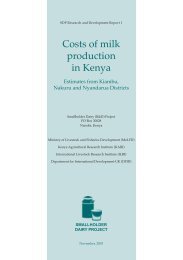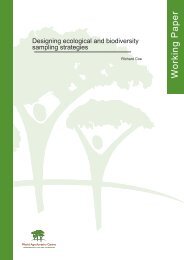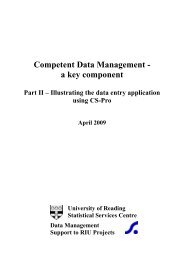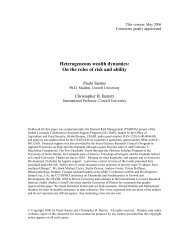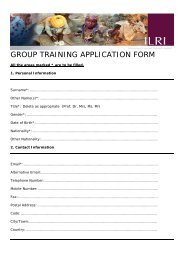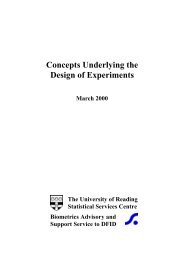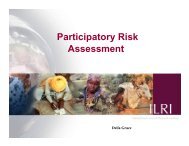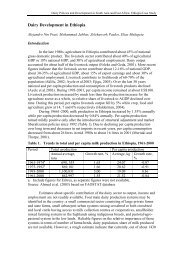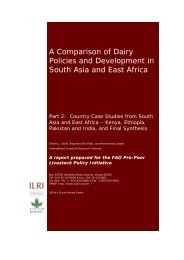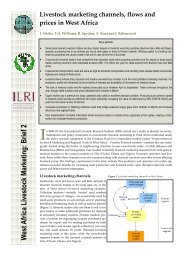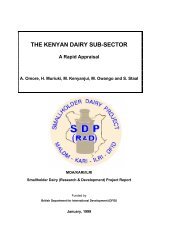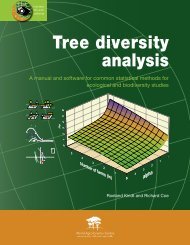and fruit) and <strong>in</strong> forests. The more progressive and richer farmers, with access to resources and credit, areassociated with semi-<strong>in</strong>tensive and <strong>in</strong>tensive production systems based on dairy<strong>in</strong>g and the fatten<strong>in</strong>g <strong>of</strong> beefcattle, pigs and poultry. <strong>Crop</strong>–animal <strong>in</strong>teractions occur. Buffaloes provide power for land preparation;buffaloes and cattle supply manure; crop residues (ma<strong>in</strong>ly rice straw) are consumed by large rum<strong>in</strong>ants; andlarge rum<strong>in</strong>ants can provide entry-po<strong>in</strong>ts for the <strong>in</strong>troduction <strong>of</strong> improved pastures <strong>in</strong> certa<strong>in</strong> situations thatwill contribute to erosion control and an improvement <strong>in</strong> soil fertility. In semi-<strong>in</strong>tensive and <strong>in</strong>tensive systems,animals are fed on better-quality roughages and concentrates. <strong>Crop</strong>s associated with these more <strong>in</strong>tensivesystems <strong>in</strong>clude rice, maize, soyabean, sugar-cane and cassava. Dairy cattle production systems, <strong>in</strong>volv<strong>in</strong>gthe use <strong>of</strong> cultivated forages such as Napier grass and Gu<strong>in</strong>ea grass, and purchased concentrates, are <strong>in</strong>creas<strong>in</strong>g<strong>in</strong> importance. The <strong>in</strong>itiation <strong>of</strong> the Thai Research Fund, with special emphasis on dairy<strong>in</strong>g, will furtherpromote the benefits <strong>of</strong> dairy<strong>in</strong>g to farmers, as well as <strong>in</strong>creas<strong>in</strong>g output to meet an expand<strong>in</strong>g domesticmarket for milk. Goats and sheep are ma<strong>in</strong>ly found <strong>in</strong> the south <strong>of</strong> Thailand <strong>in</strong> subsistence systems, wherethey are raised as a secondary enterprise to crop production.Feed resourcesBoth scientists and farmers are <strong>in</strong> agreement that the availability <strong>of</strong> feed resources, particularly <strong>in</strong> the dryseason, is the prime technical constra<strong>in</strong>t. There are also problems <strong>of</strong> feed utilisation and the <strong>in</strong>tegration <strong>of</strong>different feed resources <strong>in</strong>to diets. Most feed for large rum<strong>in</strong>ants comes from extensive native grasslands andvegetation grow<strong>in</strong>g on the roadsides, on wasteland and <strong>in</strong> fallows. However, for the first time <strong>in</strong> the ASEANsub-region, sizeable areas <strong>of</strong> improved pastures were observed on the farms. The ma<strong>in</strong> species sown areBrachiaria ruziziensis and B. decumbens, which are stall-fed or grazed by tethered animals. The stands werevery nitrogen-deficient as no artificial fertiliser is applied and were, therefore, not very productive.Furthermore, these grasses are not ideal for cutt<strong>in</strong>g. Other more productive and suitable species could begrown <strong>in</strong> the region. Stands <strong>of</strong> stylo were observed on some <strong>of</strong> the farms and on roadsides, a relic <strong>of</strong> earlierAustralian forage projects. Near the city <strong>of</strong> Sur<strong>in</strong>, legumes were observed grow<strong>in</strong>g on the bunds around ricefields, but they did not appear to be utilised either as animal feed or green-manure. Rice straw is usedextensively and is also sold for animal feed. Concentrates are fed to dairy cattle, but farmers compla<strong>in</strong> <strong>of</strong> theexpense. It is likely that, for many reasons, roughage <strong>in</strong>take is limited (some farmers cut-and-carry from adistance <strong>of</strong> three kilometres) and concentrates are be<strong>in</strong>g fed <strong>in</strong> excess to compensate for this.Amongst the four ASEAN countries visited, it is <strong>in</strong> Thailand that small farmers were found to be engagedmost actively <strong>in</strong> trad<strong>in</strong>g rice straw for feed, and manure from cattle and buffaloes for fertiliser. Input–outputprice ratios appear to favour the use <strong>of</strong> animal manure as fertiliser.The problems associated with feed resources <strong>in</strong> north-east Thailand present opportunities for research.The potential for <strong>in</strong>tegrat<strong>in</strong>g animals with perennial tree crops <strong>in</strong> the south has been referred to earlier. Thereare extensive areas <strong>of</strong> native pastures that could be improved with perennial legumes already identified fromprevious Australian forage projects; more productive and suitable cut-and-carry grasses could be established;annual legumes could be <strong>in</strong>ter-cropped or relay-cropped with rice; crop residues and AIBP could be moreefficiently utilised from a range <strong>of</strong> crops (maize, cassava, kenaf and sugar-cane); and multipurpose trees couldbe established on bunds around rice fields, on wasteland and around the homesteads. Some work has alreadybeen undertaken with L. leucocephala and Sesbania spp, but this work did not have an animal focus. The<strong>in</strong>tegration <strong>of</strong> these various feed options <strong>in</strong>to diets for rum<strong>in</strong>ants is also a researchable issue. There is anacceptance <strong>of</strong> improved pastures by farmers <strong>in</strong> north-east Thailand that should be exploited.<strong>Animal</strong> health and diseases<strong>Animal</strong> diseases recorded <strong>in</strong> Thailand are listed by Campbell (1992). The most important animal healthproblems for smallholders are foot-and-mouth disease and haemorrhagic septicaemia <strong>in</strong> large rum<strong>in</strong>ants;<strong>in</strong>ternal parasites <strong>in</strong> buffaloes; and Newcastle disease <strong>in</strong> poultry. The <strong>in</strong>cidence <strong>of</strong> foot-and-mouth diseasecan vary, but <strong>in</strong> some villages the problem occurs annually. Foot-and-mouth disease is more common <strong>in</strong> thewet season and can last for up to four weeks. However, many smallholders <strong>in</strong> the north <strong>of</strong> Thailand do notappear to perceive foot-and-mouth disease as a major animal health problem. Vacc<strong>in</strong>ation <strong>of</strong> animals variesand failure to vacc<strong>in</strong>ate may be associated with difficulties <strong>in</strong> muster<strong>in</strong>g animals and the fear <strong>of</strong> side effects
such as abortion. Vacc<strong>in</strong>ation cover will need to be raised <strong>in</strong> the area if foot-and-mouth disease is to becontrolled effectively. Indigenous breeds are resistant to diseases, e.g. yellow cattle to tick-borne diseases,Siamese long-tailed sheep to <strong>in</strong>ternal parasites, and village chicken to Newcastle disease.Socio-economic aspectsTwo farm<strong>in</strong>g-systems research projects, supported by the IDRC and the United States Agency forInternational Development (USAID), were undertaken <strong>in</strong> the late 1980s. However, only the IDRC projectwhich ran from 1984–1987 generated some economic data. The project (University <strong>of</strong> Khon Kaen 1987)showed that the <strong>in</strong>clusion <strong>of</strong> large rum<strong>in</strong>ants <strong>in</strong>to upland cropp<strong>in</strong>g systems <strong>in</strong>creased average farm <strong>in</strong>comefrom US$ 518 <strong>in</strong> 1983 to US$ 715 <strong>in</strong> 1986. Amongst the four ASEAN countries visited, the economy <strong>of</strong>Thailand has enjoyed the fastest rate <strong>of</strong> growth over the last 10 years and many <strong>of</strong> the developments thatoccurred have affected smallholders on mixed farms. Some <strong>of</strong> these will now be discussed briefly.MechanisationThere is an <strong>in</strong>creas<strong>in</strong>g trend <strong>in</strong> mechanisation <strong>of</strong> farm production activities, particularly <strong>in</strong> the irrigated riceareas <strong>of</strong> the central region, that has significantly decreased the demand for buffaloes for draft power. At thenational level, the number <strong>of</strong> small tractors <strong>in</strong>creased by 48% between 1987 and 1990. In the same period,the population <strong>of</strong> buffaloes decreased by 15%. However, with mechanisation there has been an <strong>in</strong>crease <strong>in</strong>accidents, ill-health and problems <strong>of</strong> ma<strong>in</strong>tenance <strong>of</strong> the mach<strong>in</strong>es, and some farmers have returned to us<strong>in</strong>gbuffaloes. Due to the uncerta<strong>in</strong>ty <strong>of</strong> ra<strong>in</strong>fall and the scarcity <strong>of</strong> ra<strong>in</strong> dur<strong>in</strong>g the wet season, farmers are slowlyshift<strong>in</strong>g to more speedy means <strong>of</strong> tillage, which is possible only through mechanisation. S<strong>of</strong>t credit termshave also fuelled the demand for small tractors. In north-east Thailand, the population <strong>of</strong> buffaloes hasrema<strong>in</strong>ed relatively constant dur<strong>in</strong>g the last 10 years despite a nation-wide decl<strong>in</strong>e <strong>in</strong> numbers. It is anticipatedthat, <strong>in</strong> the region, buffaloes will cont<strong>in</strong>ue to contribute significantly to the draft power needs <strong>of</strong> small farmers.Opportunities for us<strong>in</strong>g buffaloes for meat production should encourage farmers to <strong>in</strong>crease their numbers.Labour shortagesThere is a rapid rate <strong>of</strong> rural–urban migration amongst the younger members <strong>of</strong> rural households to work <strong>in</strong>newly established manufactur<strong>in</strong>g and service <strong>in</strong>dustries and on construction projects. The rapid rate <strong>of</strong> growth<strong>in</strong> the non-agricultural sector has created good job opportunities <strong>in</strong> many parts <strong>of</strong> the country. Mostcommonly, only the older members <strong>of</strong> the household rema<strong>in</strong> on the farm. Accord<strong>in</strong>gly, the role <strong>of</strong> women <strong>in</strong>farm operations has become even more significant, and as many as 50% <strong>of</strong> women are <strong>in</strong>volved <strong>in</strong> the rear<strong>in</strong>g<strong>of</strong> animals. Increased mechanisation and labour shortages <strong>in</strong> some areas may change the species balance andmethods <strong>of</strong> animal production <strong>in</strong> future.Increas<strong>in</strong>g land valuesLand rents are <strong>in</strong>creas<strong>in</strong>g rapidly due to the demand for land for non-agricultural uses. Community graz<strong>in</strong>gareas are decl<strong>in</strong><strong>in</strong>g, especially near the urban centres, and the availability <strong>of</strong> feed resources is <strong>in</strong>creas<strong>in</strong>glythe major constra<strong>in</strong>t to production for smallholders. Alternative feed resources and feed<strong>in</strong>g systems,consistent with the resource endowments <strong>of</strong> farmers, need to be developed.Illegal imports <strong>of</strong> large rum<strong>in</strong>antsThere is a constant and illegal <strong>in</strong>flux <strong>of</strong> cattle and buffaloes from the neighbour<strong>in</strong>g countries, the Lao PDRand Myanmar. Road <strong>in</strong>frastructure is relatively good, compared to the Philipp<strong>in</strong>es and Indonesia, mak<strong>in</strong>g<strong>in</strong>ter-regional movement <strong>of</strong> agricultural commodities (<strong>in</strong>clud<strong>in</strong>g live animals) relatively efficient. Althoughdata on prices are not available, the movement <strong>of</strong> animals across the borders is an <strong>in</strong>dication <strong>of</strong> the lowerprices <strong>in</strong> the countries <strong>of</strong> orig<strong>in</strong>. This <strong>in</strong>evitably creates a dis<strong>in</strong>centive amongst local farmers to raise theirown animals.Policy emphasis on dairy productionAmongst the animals raised by smallholders, dairy cattle have received the best support. Pric<strong>in</strong>g policies andother support services (e.g. credit and extension) are provided most liberally to dairy producers. Currently, the
- Page 2 and 3:
Affiliation of Authors:Dr C. Devend
- Page 4 and 5:
6.Strategyfor researchJustification
- Page 7 and 8:
AcknowledgementsThe International L
- Page 9 and 10:
esearch opportunities appropriate t
- Page 11 and 12:
Table 1.Animal populations and meat
- Page 13 and 14:
Introduction2. Characterisation and
- Page 15 and 16:
Figure 2. Sub-humid tropics and sub
- Page 17 and 18:
Table 3.Human and animal population
- Page 19 and 20:
Table 5. Rice-growing environments
- Page 21 and 22:
Multiple upland annual crop systems
- Page 23 and 24:
Table 6. Continued.Country Importan
- Page 25 and 26:
It should be noted that, compared w
- Page 27 and 28:
Table 8.CountryCambodiaChinaIndones
- Page 29 and 30:
of non-renewable fossil fuels and t
- Page 31 and 32:
Overview of researchThere was a sur
- Page 33 and 34:
• Identification of alternative c
- Page 35 and 36:
Various animal production systems t
- Page 37 and 38:
Presently, much of the vegetable pr
- Page 39 and 40:
Table 10. Summary of the main socio
- Page 41 and 42: Table 11. Institutions and organisa
- Page 43 and 44: 3. In the ASEAN sub-region, inadequ
- Page 45 and 46: Table 12. Continued.SituationsPract
- Page 47 and 48: 6. Strategy for researchJustificati
- Page 49 and 50: Table 13. Priorities for research a
- Page 51 and 52: VietnamResearch capacity in NARS is
- Page 53 and 54: CRIFC (Central Research Institute f
- Page 55 and 56: IAS. 1995. Proceedings of the Works
- Page 57 and 58: Systems of sub-Saharan Africa. Volu
- Page 59 and 60: or waterlogged in the wet season an
- Page 61 and 62: Table A1. Important diseases of ani
- Page 63 and 64: • Increased cropping intensities,
- Page 65 and 66: the animal output came from pigs al
- Page 67 and 68: 18-21° North, with an average rain
- Page 69 and 70: In the Nusa Tenggara islands, signi
- Page 71 and 72: Women work 11.5 h/day on average co
- Page 73 and 74: Various Australian forage projects
- Page 75 and 76: village production systems; to stud
- Page 77 and 78: The availability of feed in rubber
- Page 79 and 80: of the Ayeyarwady and Sittang river
- Page 81 and 82: Constraints and opportunitiesInadeq
- Page 83 and 84: gaining in importance, and signific
- Page 85 and 86: Table A3. Characterisation of crop-
- Page 87 and 88: Table A4. Interventions in crop-ani
- Page 89 and 90: Table A4. Continued.Project TitleGo
- Page 91: otations are practised, and there a
- Page 95 and 96: large areas of forests (3.4 million
- Page 97 and 98: Table A6. Some animal diseases repo
- Page 99 and 100: Appendix IIItineraryThe Philippines
- Page 101 and 102: 26 November 1996 am Visit to small
- Page 103 and 104: Appendix IIIList of persons metPhil
- Page 105 and 106: Mr Chhiv Nan, Acting Director, Depa
- Page 107 and 108: Dr U Maung Ngint, Managing Director
- Page 109: List of acronymsAARDACIARADBAEZAIBP



